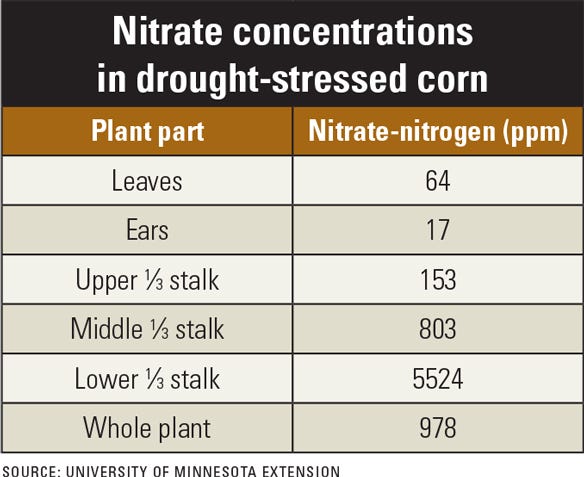August 10, 2021

The drought in Minnesota has caused some areas of corn to dry down enough for chopping as silage.
University of Minnesota Extension specialists advise, where possible, to delay corn silage harvest as long as possible to allow for maximum development of the kernels and total dry matter.
In a recent blog, Extension specialists Emily Popp, Nathan Drewitz, Jared Goplen, Liz Stahl, Craig Sheaffer and Jeffrey Coulter offered the following reminders and advice regarding drought-stressed corn and corn silage.
Check ear development. Assess grain to help determine harvest timing. Fields with plants that have some grain development should be left for as long as possible to allow the grain to develop further. If pollination was unsuccessful and ears are barren of kernels, harvest should occur as soon as the plant moisture is appropriate for storage.
Expect forage quality of drought-stressed corn silage to be variable because of variation in plant height, maturity, and grain fill within a field. Also, expect greater starch production with increased grain fill. If there is little or no grain, levels of crude protein and fiber content may be higher, but energy content will be lowered compared to corn silage containing grain. Make sure you test corn silage for nutrient content, as rations may need to be adjusted compared to corn silage in a more typical year.
Monitor silage harvest moisture. Test the moisture level of corn silage before and during chopping. Silage moisture is an important factor in the ensiling process, and the moisture content of drought-stressed corn can be deceiving. Even if the corn looks fired up and dried out, it may still contain over 70% moisture.
When testing for moisture, pull representative samples from the field. A Koster tester or microwave can provide an accurate estimate of the silage moisture level. Test often, because silage that is too wet or too dry will have storage issues. Silage chopped too wet can become clostridial, and nutrients can seep from storage structures. Silage that is too dry will not pack well, increasing the potential for air pockets, mold and storage losses.
It is possible to add moisture to dry corn silage, but it is usually not feasible as it takes large amounts of water to increase moisture. For example, it takes 7 gallons of water per 1 ton of silage to raise the moisture level by 1%.
Recommended moisture levels for the different storage options of corn silage are: 65% to 70% for bunkers, 60% to 70% for bags, 60% to 65% for upright stave silos, 55% to 60% for upright oxygen-limiting silos, and 40% to 55% for baleage.
Test for nitrates. Nitrates taken up by plants are normally incorporated into amino acids, the building blocks of proteins. The conversion of nitrates to amino acids usually occurs in green leaf tissue. Drought conditions can cause nitrates to accumulate in the plants, especially in the lower one-third of the stalk.
 Nitrate concentrations in drought-stressed corn
Nitrate concentrations in drought-stressed corn

Raise the cutting deck to a height of 10 to 12 inches to avoid stalks that are highest in nitrates. This will decrease tonnage. The whole-plant nitrate concentration should factor into the decision of cutting height. Harvest should also be delayed a minimum of three days following a rainfall event, as a flush of nitrates can enter the plant, temporarily increasing nitrate concentrations.
If ensiled properly, one-third to one-half of the nitrates will be converted and released as a gas. Test the silage during feedout to ensure you’re not feeding unsafe nitrate levels, taking into account the nitrate level in the corn silage and the proportion of corn silage in the ration.
Greenchopping drought-stressed corn is not recommended. as nitrates will likely be high without fermentation.
Chop length also plays a role in the ensiling process. The theoretical length of cut for processed corn silage is three-quarters of an inch; if not processed, the length should be one-quarter to one-half inch. If harvesting corn silage that is drier than recommended, decreasing the cutting size may help with packing. Using an inoculant can also increase the chances of successful fermentation. With reduced yields, it is critical to preserve the forage we do have.
Be aware of silo gas. The nitrate-nitrogen that is released as a gas during fermentation includes various nitrogen oxide gases that are lethal to humans and livestock. These gases are heavier than air and will accumulate above the silage in a silo; they can flow down the chute, into the silo room and out the silo juice drain. Some of these lethal gases are colorless and odorless — so as always use extreme caution around silos. and have an emergency action plan in place.
Baleage is better than dry-corn baling. If stacking or baling drought-stressed corn as dry hay, make sure to dry down to <20% moisture to avoid storage issues. This can be nearly impossible to do without ideal drying conditions. Since this material isn’t ensiled, it is especially important to test for high nitrates. Baleage is a better alternative to baling corn dry, as it excludes oxygen and will ensile if dense bales are made and wrapped properly. For bale silage, bale at 40% to 55% moisture, and wrap with a minimum of 6 millimeters of plastic (about seven to eight wraps).
Check pesticide labels. Before harvesting drought-stressed corn for forage, check the labels of any pesticides used in the crop. Be sure to follow the preharvest intervals listed in the label prior to harvest.
Contact your crop insurance agent. For insured crops, be sure to contact your crop insurance agent before harvesting or before changes are made to the crop to ensure coverage.
Source: University of Minnesota Extension, which is solely responsible for the information provided and is wholly owned by the source. Informa Business Media and all of its subsidiaries are not responsible for any of the content contained in this information asset.
You May Also Like




